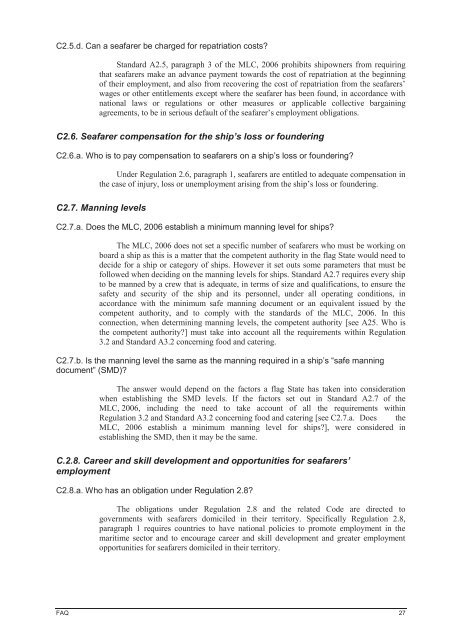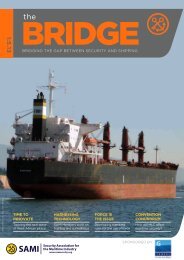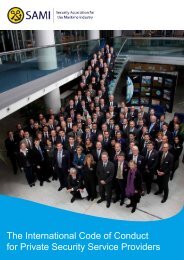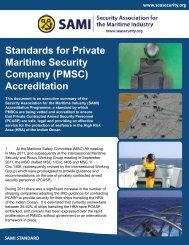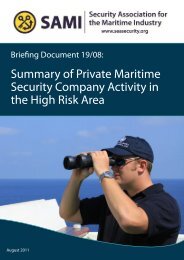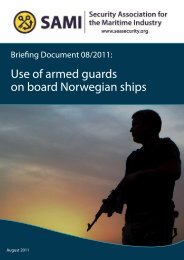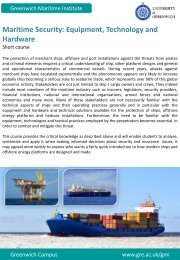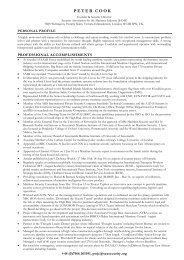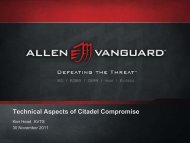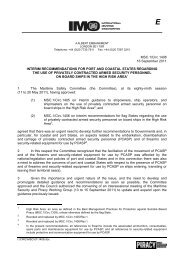C2.5.d. Can a seafarer be charged for repatriation costs?St<strong>and</strong>ard A2.5, paragraph 3 of the MLC, 2006 prohibits shipowners from requiringthat seafarers make an advance payment towards the cost of repatriation at the beginningof their employment, <strong>and</strong> also from recovering the cost of repatriation from the seafarers’wages or other entitlements except where the seafarer has been found, in accordance withnational laws or regulations or other measures or applicable collective bargainingagreements, to be in serious default of the seafarer’s employment obligations.C2.6. Seafarer compensation for the ship’s loss or founderingC2.6.a. Who is to pay compensation to seafarers on a ship’s loss or foundering?Under Regulation 2.6, paragraph 1, seafarers are entitled to adequate compensation inthe case of injury, loss or unemployment arising from the ship’s loss or foundering.C2.7. Manning levelsC2.7.a. Does the MLC, 2006 establish a minimum manning level for ships?The MLC, 2006 does not set a specific number of seafarers who must be working onboard a ship as this is a matter that the competent authority in the flag State would need todecide for a ship or category of ships. However it set outs some parameters that must befollowed when deciding on the manning levels for ships. St<strong>and</strong>ard A2.7 requires every shipto be manned by a crew that is adequate, in terms of size <strong>and</strong> qualifications, to ensure thesafety <strong>and</strong> security of the ship <strong>and</strong> its personnel, under all operating conditions, inaccordance with the minimum safe manning document or an equivalent issued by thecompetent authority, <strong>and</strong> to comply with the st<strong>and</strong>ards of the MLC, 2006. In thisconnection, when determining manning levels, the competent authority [see A25. Who isthe competent authority?] must take into account all the requirements within Regulation3.2 <strong>and</strong> St<strong>and</strong>ard A3.2 concerning food <strong>and</strong> catering.C2.7.b. Is the manning level the same as the manning required in a ship’s “safe manningdocument” (SMD)?The answer would depend on the factors a flag State has taken into considerationwhen establishing the SMD levels. If the factors set out in St<strong>and</strong>ard A2.7 of theMLC, 2006, including the need to take account of all the requirements withinRegulation 3.2 <strong>and</strong> St<strong>and</strong>ard A3.2 concerning food <strong>and</strong> catering [see C2.7.a. Does theMLC, 2006 establish a minimum manning level for ships?], were considered inestablishing the SMD, then it may be the same.C.2.8. Career <strong>and</strong> skill development <strong>and</strong> opportunities for seafarers’employmentC2.8.a. Who has an obligation under Regulation 2.8?The obligations under Regulation 2.8 <strong>and</strong> the related Code are directed togovernments with seafarers domiciled in their territory. Specifically Regulation 2.8,paragraph 1 requires countries to have national policies to promote employment in themaritime sector <strong>and</strong> to encourage career <strong>and</strong> skill development <strong>and</strong> greater employmentopportunities for seafarers domiciled in their territory.FAQ 27
C3. Title 3 Accommodation, recreational facilities, food <strong>and</strong> cateringC3.1. Accommodation <strong>and</strong> recreational facilitiesC3.1.a. Do the accommodation requirements of Title 3 apply to existing ships?Regulation 3.1, paragraph 2, of the MLC, 2006 provides that the requirements in theCode that relate to ship construction <strong>and</strong> equipment apply only to ships constructed on orafter the date when the MLC, 2006, comes into force for the flag State. For shipsconstructed before the entry into force for the flag State, the requirements relating to shipconstruction <strong>and</strong> equipment that are set out in the Accommodation of Crews <strong>Convention</strong>(Revised), 1949 (No. 92), 21 <strong>and</strong> the Accommodation of Crews (Supplementary Provisions)<strong>Convention</strong>, 1970 (No. 133), 22 apply to the extent that they were already applicable, underthe law or practice of the Member concerned.One or both of those <strong>Convention</strong>s may have become applicable through ratificationby the country concerned. Or their substance may have become applicable through thecountry’s ratification of the Merchant Shipping (Minimum St<strong>and</strong>ards) <strong>Convention</strong>, 1976(No. 147) 23 <strong>and</strong>/or the 1996 Protocol to <strong>Convention</strong> No. 147; 24 there may also be caseswhere <strong>Convention</strong>s Nos 92 <strong>and</strong> 133 have not been ratified but have been made applicableunder the country’s national law. Even if a country has not ratified any of these<strong>Convention</strong>s all ships must comply with the basic requirement in Regulation 3.1,paragraph 1 that they "provide <strong>and</strong> maintain decent accommodations <strong>and</strong> recreationalfacilities for seafarers working or living on board, or both, consistent with promoting theseafarers' health <strong>and</strong> well-being" in accordance with the ships' national legislation. Allother requirements in the MLC, 2006, as implemented nationally, including those inSt<strong>and</strong>ard A3.1 that are not related to construction <strong>and</strong> equipment, will apply to shipsconstructed before the MLC, 2006, entered into force for the flag State.C3.1.b. Can sleeping rooms be located below a ship’s load line?Under St<strong>and</strong>ard A3.1, paragraph 6(c) <strong>and</strong> (d) of the MLC, 2006, in ships other thanpassenger ships <strong>and</strong> special purpose ships [see C3.1.c. What are “special purpose ships”?],sleeping rooms must be situated above the load line amidships or aft, except that inexceptional cases, where the size, type or intended service of the ship renders any otherlocation impracticable, sleeping rooms may be located in the fore part of the ship, but in nocase forward of the collision bulkhead. In passenger ships <strong>and</strong> special purpose ships thecompetent authority [see A25. Who is the competent authority?] may, on condition thatsatisfactory arrangements are made for lighting <strong>and</strong> ventilation, permit the location ofsleeping rooms below the load line, but in no case can they be located immediately beneathworking alleyways.21 To be found at: www.ilo.org/normes22 ibid.23ibid.24 ibid.28 FAQ
- Page 8: C5.1. Flag State responsibilities .
- Page 11 and 12: the Convention regarding the need f
- Page 13 and 14: oard ships but are not directly inv
- Page 15 and 16: supervisory system (a system establ
- Page 18 and 19: A16. How does the MLC, 2006 make it
- Page 20 and 21: A19. What will happen to the mariti
- Page 22 and 23: B. Questions about the workers andt
- Page 27 and 28: authority?] as qualified to issue s
- Page 29 and 30: C1.3.b. Does this training requirem
- Page 31 and 32: It may be useful to also consider t
- Page 33 and 34: equirements for upgrading or promot
- Page 35: C2.3.h. Do the hour of rest and hou
- Page 39 and 40: y berths and lockers, chests of dra
- Page 41 and 42: C4.1.b. Must every ship have a ship
- Page 43 and 44: • the cost of safeguarding the pr
- Page 45 and 46: (b) facilities for sports and outdo
- Page 47 and 48: • Sickness benefit• Unemploymen
- Page 49 and 50: agreed upon international standards
- Page 51 and 52: provisions of Regulation 5.1.3 and
- Page 53 and 54: C5.1.o. What is the period of valid
- Page 55 and 56: (b)(c)to carry out any examination,
- Page 57 and 58: prevents ships being delayed by unn
- Page 59 and 60: certificate and DMLC should be the
- Page 61 and 62: C5.2.q. Are complaints confidential
- Page 64 and 65: INTERNATIONAL LABOUR CONFERENCECont
- Page 66 and 67: Maritime Labour Convention, 2006MAR
- Page 68 and 69: Maritime Labour Convention, 2006(b)
- Page 70 and 71: Maritime Labour Convention, 20062.
- Page 72 and 73: Maritime Labour Convention, 2006Pla
- Page 74: Maritime Labour Convention, 20062.
- Page 78: Explanatory note to the Regulations
- Page 82 and 83: Minimum requirements for seafarers
- Page 84 and 85: Minimum requirements for seafarers
- Page 86 and 87:
Minimum requirements for seafarers
- Page 88 and 89:
Minimum requirements for seafarers
- Page 90 and 91:
Conditions of employmentTITLE 2. CO
- Page 92 and 93:
Conditions of employmentGuideline B
- Page 94 and 95:
Conditions of employment3. National
- Page 96 and 97:
Conditions of employment(a) hours o
- Page 98 and 99:
Conditions of employment4. Paragrap
- Page 100 and 101:
Conditions of employmentRegulation
- Page 102 and 103:
Conditions of employment(b) accommo
- Page 104 and 105:
Conditions of employmentciently and
- Page 106 and 107:
Accommodation, recreational facilit
- Page 108 and 109:
Accommodation, recreational facilit
- Page 110 and 111:
Accommodation, recreational facilit
- Page 112 and 113:
Accommodation, recreational facilit
- Page 114 and 115:
Accommodation, recreational facilit
- Page 116 and 117:
Accommodation, recreational facilit
- Page 118 and 119:
Accommodation, recreational facilit
- Page 120 and 121:
Health protection, medical care, we
- Page 122 and 123:
Health protection, medical care, we
- Page 124 and 125:
Health protection, medical care, we
- Page 126 and 127:
Health protection, medical care, we
- Page 128 and 129:
Health protection, medical care, we
- Page 130 and 131:
Health protection, medical care, we
- Page 132 and 133:
Health protection, medical care, we
- Page 134 and 135:
Health protection, medical care, we
- Page 136 and 137:
Health protection, medical care, we
- Page 138 and 139:
TITLE 5. COMPLIANCE AND ENFORCEMENT
- Page 140 and 141:
Compliance and enforcement(a) has t
- Page 142 and 143:
Compliance and enforcement7. Detail
- Page 144 and 145:
Compliance and enforcement14. A cer
- Page 146 and 147:
Compliance and enforcement5. If a M
- Page 148 and 149:
Compliance and enforcement(a) the i
- Page 150 and 151:
Compliance and enforcementGuideline
- Page 152 and 153:
Compliance and enforcement(c)(d)the
- Page 154 and 155:
Compliance and enforcementStandard
- Page 156 and 157:
APPENDIX A5-IThe working and living
- Page 158 and 159:
Appendix A5-IIThis is to certify:1.
- Page 160 and 161:
Appendix A5-IIMaritime Labour Conve
- Page 162 and 163:
Appendix A5-IISignature: ..........
- Page 166 and 167:
Appendix A5-IIThis Certificate is v
- Page 168 and 169:
APPENDIX B5-I - EXAMPLE OF A NATION
- Page 170:
Appendix B5-IDeclaration of Maritim


